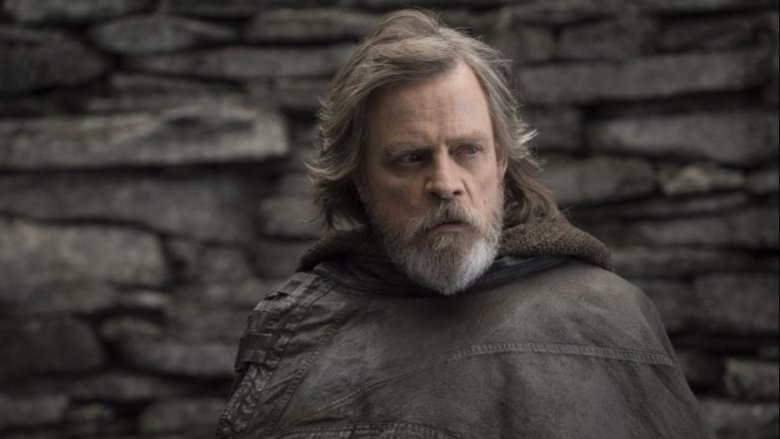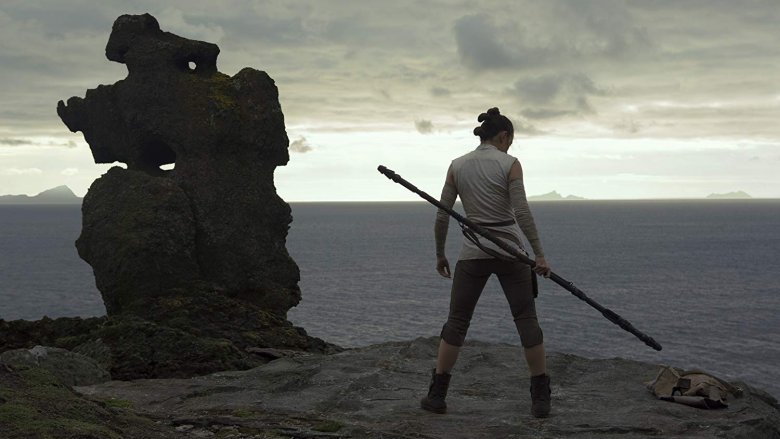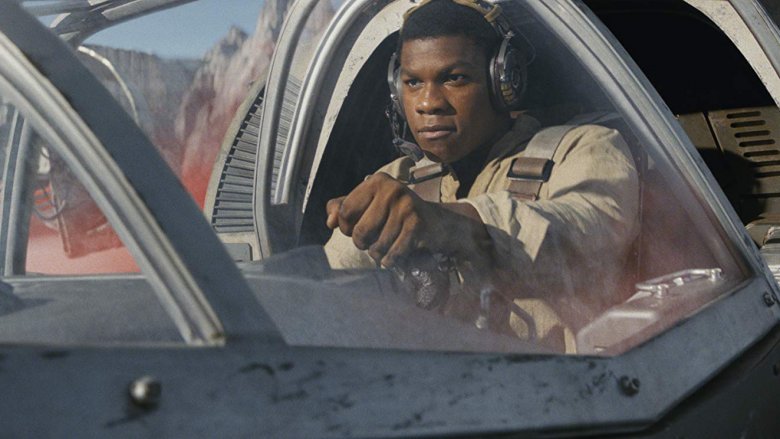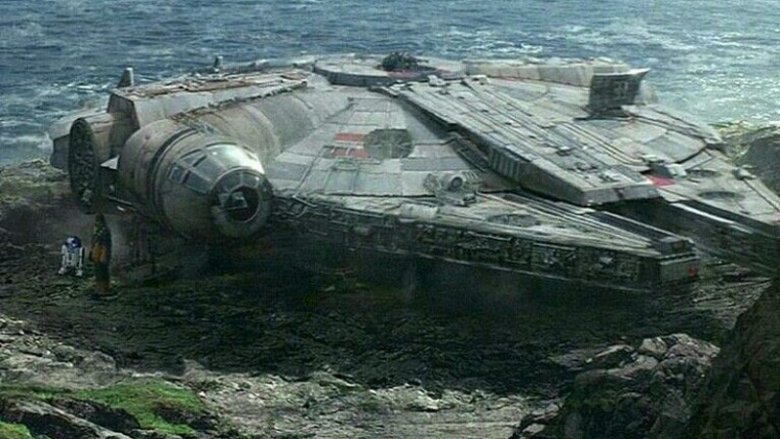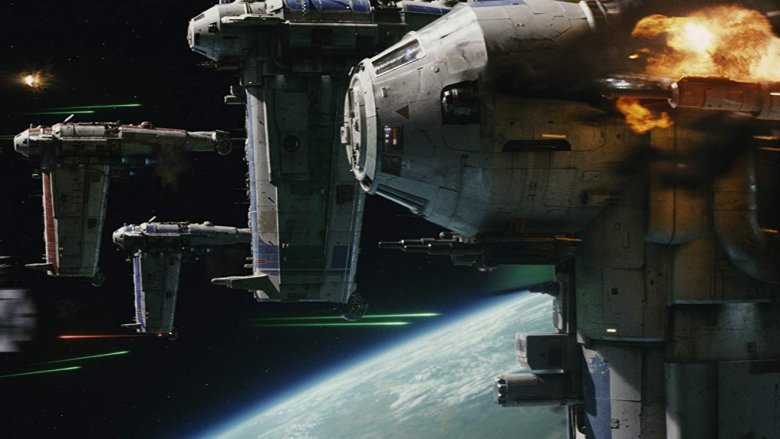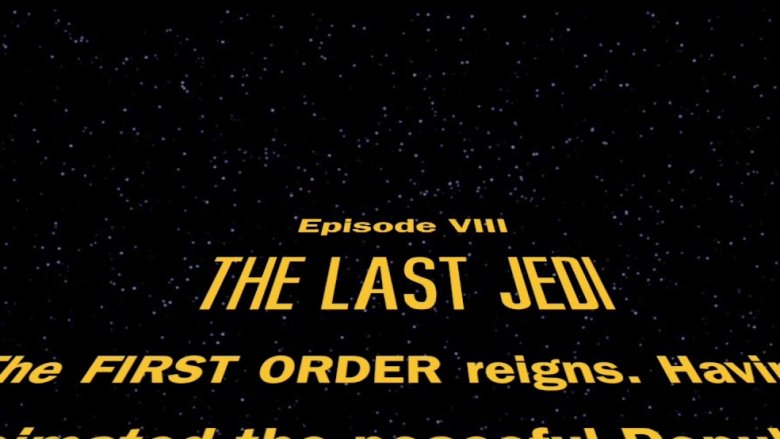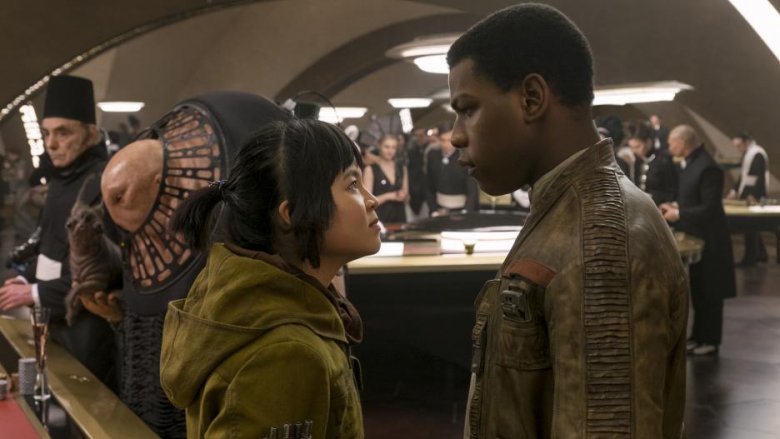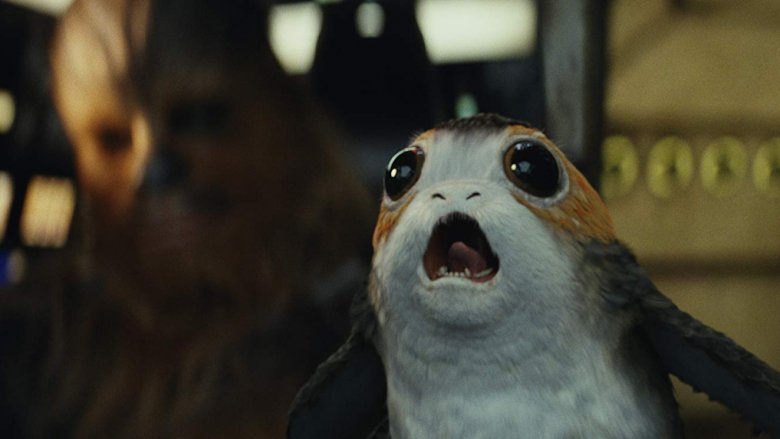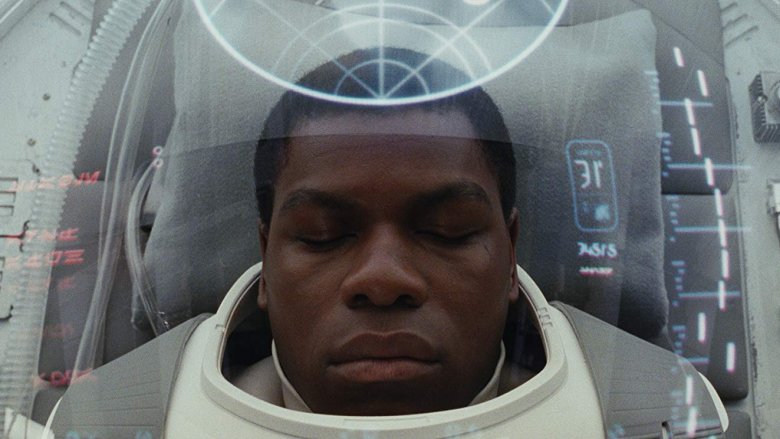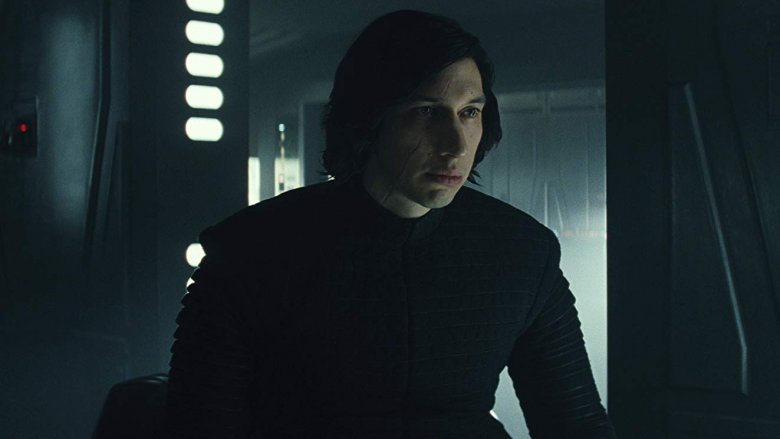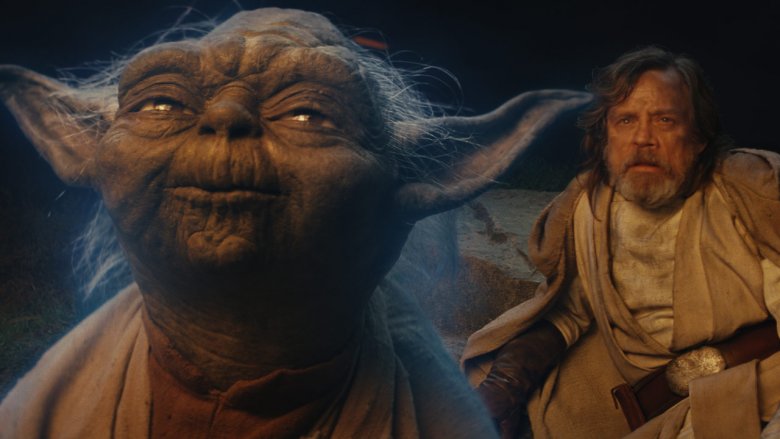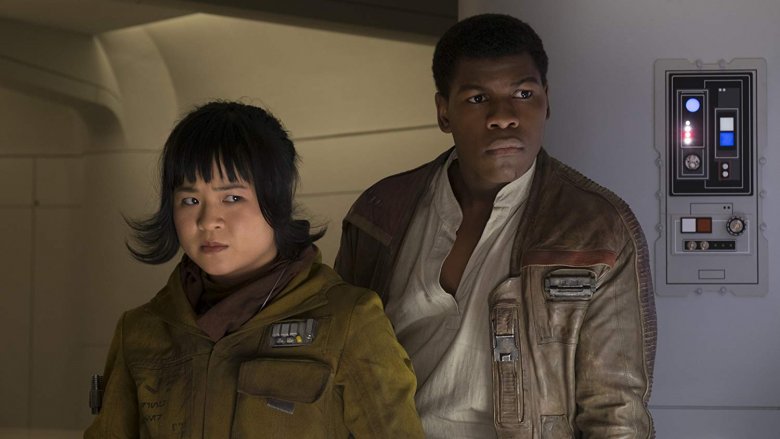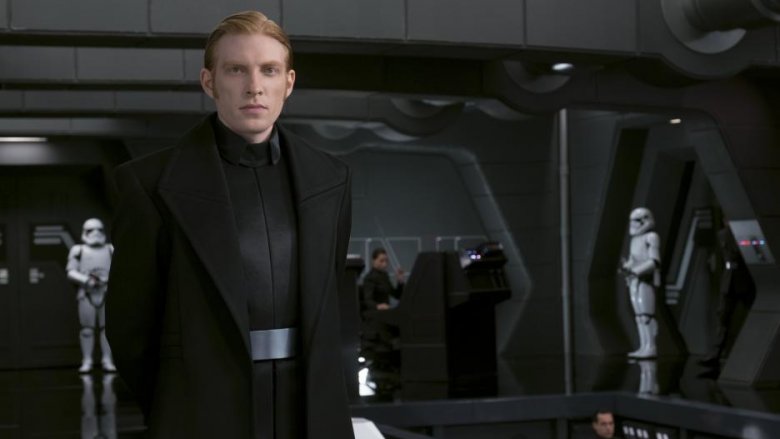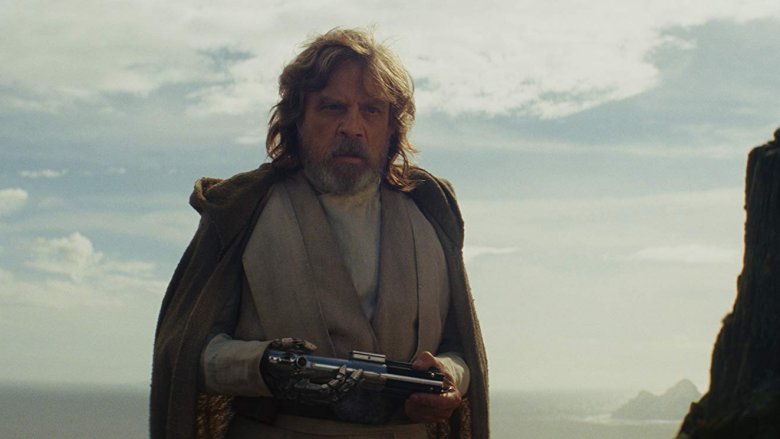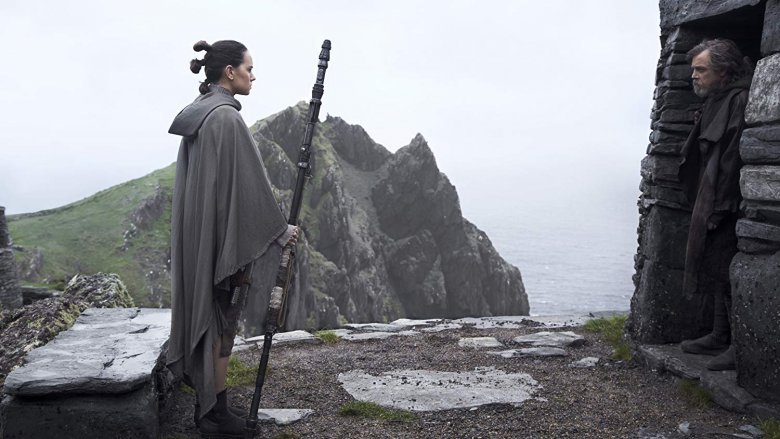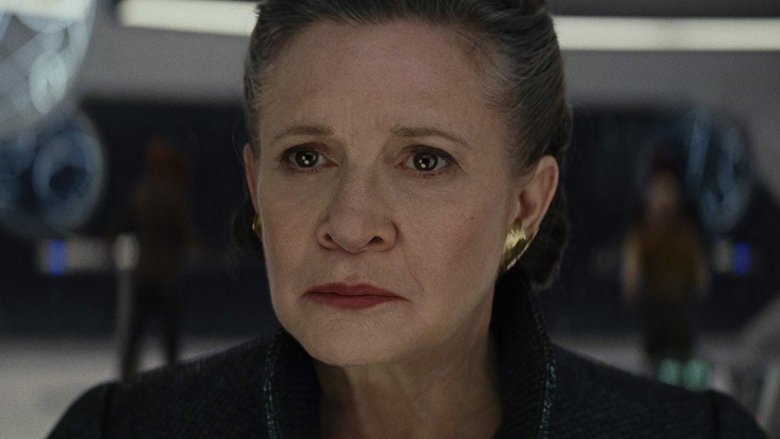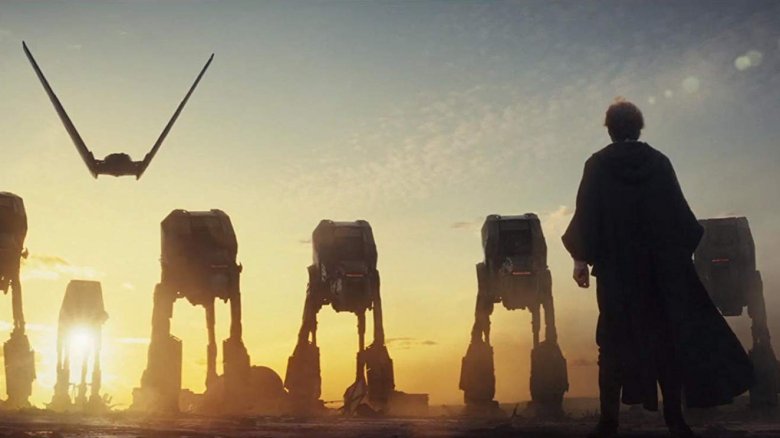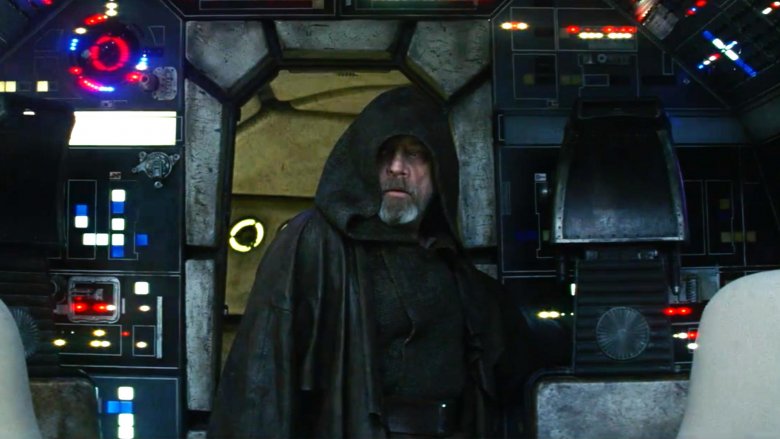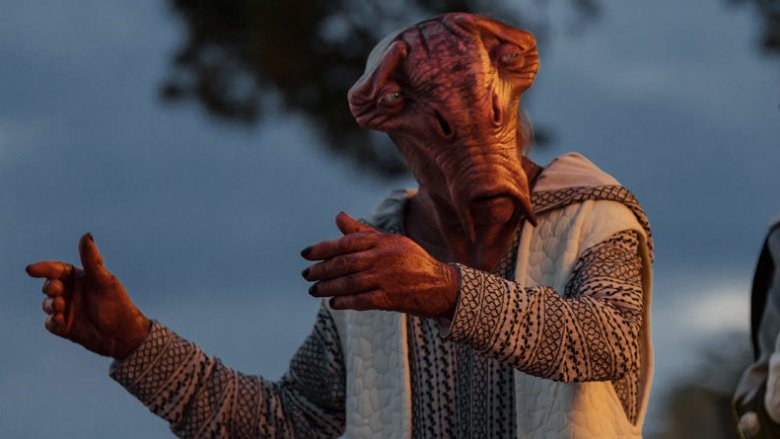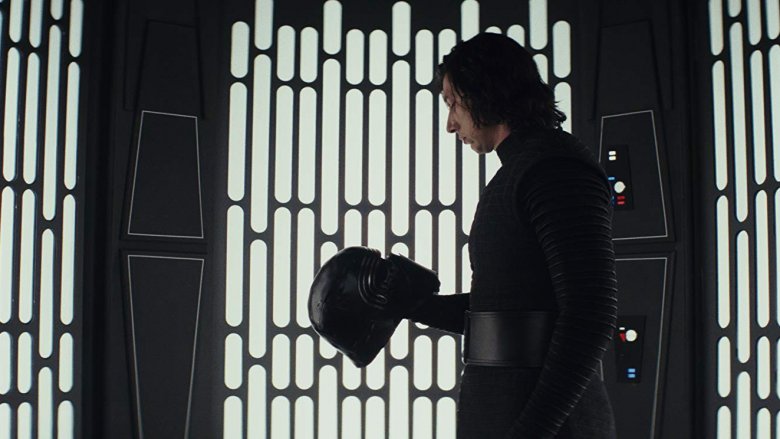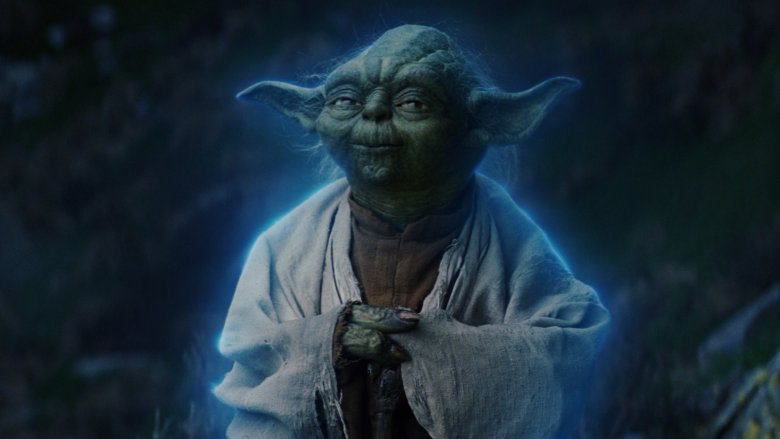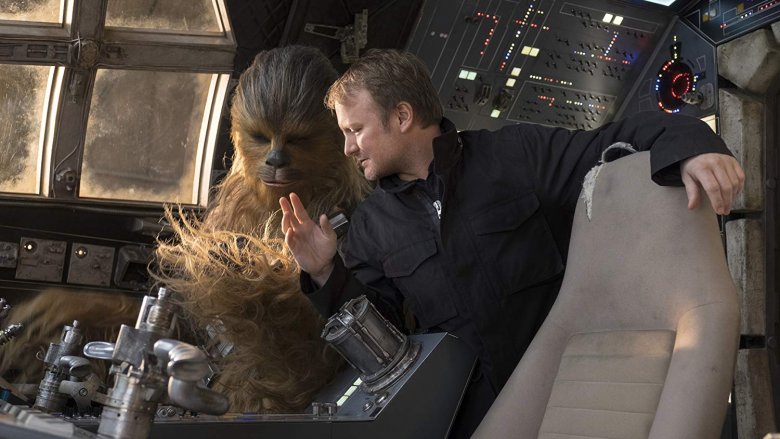The Untold Truth Of Star Wars: The Last Jedi
In 2017 writer/director Rian Johnson released his first Star Wars film, the middle installment of the third trilogy of films in what's been dubbed "The Skywaker Saga." Working from the groundwork laid by J.J. Abrams with Star Wars: The Force Awakens, Johnson assembled a cast that united new characters and old, building upon the sequel trilogy gang while enriching the legendary heroes of the saga's past. He set out to tell a story that would both still feel like a Star Wars film and challenge everything we thought we knew about a galaxy far, far away.
Star Wars: The Last Jedi was a mammoth filmmaking effort, featuring dozens of detailed sets, hundreds of practical creature designs, a shooting schedule that's been compared to a house of cards, and a thousand other intricacies. The result is one of the most complex — and controversial — stories in Star Wars history, with an equally complex filmmaking process behind it. This is the untold truth of how Star Wars: The Last Jedi was made.
It all began with a title
As with each installment of the new Star Wars trilogy, the title of The Last Jedi was kept a secret until the first trailer was released, leaving a long potential window in which Johnson could have tweaked or even changed his title entirely. Even as the title remained a secret, the whole internet was attempting to guess what the next film in the saga would be called, and wondering if a correct guess would lead to Lucasfilm releasing the title earlier than planned. According to Johnson, despite the long wait between conception and reveal, the title was actually one of the first things he came up with, and he never wavered in his commitment to it.
"I had that title from the word go, really before I even started typing the script, when I was still coming up with the story," he said during an interview with Collider. "For some reason, that title just seemed really, really right to me, and it never changed. It felt so right to me that I was constantly petrified that it was either gonna leak online or somebody was gonna guess it, because I actually thought it was a pretty obvious title."
The characters came first
Just as director J.J. Abrams found himself in the unique position of being the first person other than George Lucas to start a new Star Wars trilogy with The Force Awakens, Johnson found himself in the unique position of being the first person to try and contribute a middle Star Wars chapter without Lucas' involvement, and he had to do it with characters who'd only just been brought to life through Abrams and co-writer Lawrence Kasdan. It was a lot to juggle, so to help him gain a sense of direction on The Last Jedi, even before he wrote the script, Johnson simply decided to take stock of his characters and where they were headed. It was this technique that helped jumpstart the actual script, as he recalled in the documentary The Director and The Jedi, which was included as a bonus feature on The Last Jedi home release.
"I wrote down the names of each one of the characters, and I started just saying 'What do I know about each of these characters? What do I think they want? Where can I see them going and What would be the hardest thing for each of them to come up against?' And so that was really the starting point of the whole thing."
A request for J.J. Abrams
Johnson was just beginning production on The Last Jedi as Abrams was wrapping up production on The Force Awakens, and while Johnson had access to Abrams' scripts as he was crafting his own story, he was not directly involved with the first film in the sequel trilogy, except in one shot at the very end of the film. According to Johnson, he asked Abrams to make one small change to his film that would turn out to be a big favor for The Last Jedi.
"Yes ... The big [favor] was, I asked if R2 could come with Rey, and if BB-8 could stay behind with the Resistance," Johnson told Entertainment Weekly. "Originally it was BB-8 who went with Rey, which makes sense for the story in a way. But I asked, 'Can you do me this solid and switch the droids?'"
"I asked him if he could switch the droids, and he was super, super gracious and did that."
Having R2-D2 onboard the Millennium Falcon to meet up with his old master Luke Skywalker turned out to be a key part of Johnson's plan, as it allowed the droid to play back old footage of Princess Leia in an effort to convince Luke to help Rey train in the ways of The Force.
The films that inspired it
Even before photography began on The Last Jedi, Rian Johnson began working with his collaborators at Lucasfilm to ensure that the tone he set with his film felt right. This included a close collaboration with the Lucasfilm Story Group, the minds responsible for keeping all of Star Wars lore consistent and intertwined. According to Johnson, he set up a "film camp" of sorts for the Story Group to make sure they understood the tone of what he was going for, screening several key films that he hoped would be influences on The Last Jedi. Among those films were The Bridge on the River Kwai and Twelve O'Clock High, both World War II period dramas, the Soviet adventure film Letter Never Sent, and the samurai film Three Outlaw Samurai.
"We're just at the end of production right now. And particularly Twelve O'Clock High, a lot of that made it in there," Johnson said at Star Wars Celebration Europe in 2016. "It ended up being a really personal part of it."
The stress of the opening crawl
After coming up with his title and figuring out where his characters were and where he wanted them to go, Johnson was finally ready to sit down and start working on the script for The Last Jedi. Since the first thing viewers see in the film after the Lucasfilm logo and the famous "A long time ago in a galaxy far, far away..." prelude is the opening text crawl, Johnson decided to knock out a first draft of The Last Jedi's crawl as "a good way to kind of jump into the pool" of Star Wars storytelling.
Though he began working on the crawl early in the process, it also ended up being the piece of writing that took the longest, as Johnson later recalled tweaking word choice and grammar for the crawl right up until he had to turn a final cut of the film over to Disney.
"It was the very last piece of writing in the movie that we were working on," he explained to Collider. "Literally like a few days before we had to give the movie up and say 'OK, we can't touch it anymore' I was in there with the guys. We had like our temp version of it in our graphics program and we were tweaking grammar and tweaking words in it. There's no room for error in terms of it just flowing."
It featured an incredible number of sets
Even among Star Wars films, The Last Jedi is a particularly ambitious movie in terms of locations, taking the viewer everywhere from the islands of Ahch-To to Supreme Leader Snoke's Throne Room to the salt plains of Crait and numerous other locations in between. Johnson was determined to use as many practical sets as possible. When it was all tallied up, that led to a massive 120 different sets spread throughout the film. This left producer Ram Bergman with quite a dilemma, as the production literally did not have enough manpower or resources to build that many sets in the time they had scheduled.
"Practically, this is impossible," Bergman said in The Director and The Jedi.
Bergman and the crew were left with two choices when faced with this impossible task. They could cut some sets from the production, or they could combine sets, redressing and repurposing as they went. This created its own unique problems, as each set had to be used for principal photography and then converted for other scenes with all of the production detail — everything from lighting to set dressing to props — that entailed. This created a delicate scheduling issue that could be upset if so much as one actor had to take a sick day.
"It's really house of cards," Bergman said. "Everything needs to be like so perfect in terms of the schedule."
It also featured an incredible number of creatures.
In true Star Wars tradition, Johnson was also keen to use as many practical visual effects as possible, including characters designed by Neal Scanlan's creature shop. The film had numerous opportunities to drop in new creatures, particularly in the massive Canto Bight casino set, so Scanlan and his crew went above and beyond. In The Director and The Jedi, Scanlan noted that the film had more creatures than The Force Awakens and Rogue One combined, and later elaborated on just how many creatures we're talking about.
"There are more practical effects in this film than any Star Wars film. And I think there's over 180 to maybe 200 elements of practical creatures, characters or Droids," he told SlashFilm. "Whether they'll make it to the cut, I'm not sure. There's inevitably going to be some losses. The runtime would be about seven hours otherwise. But yeah, so far, we've never made this many different things. And in a sense, there are a lot of what I would call vignette moments in this film which are beautifully designed for practical moments in a sense. Rian's very clever in his scriptwriting to kind of visualize this as a moment. He was very keen that we take the practical effects to live real locations, for instance. So we're not just studio-based all the time. So it opened up a huge scope of possibilities and opportunities."
Its original opening was a fake-out
It's Star Wars tradition that the opening shot of each film uses the black background of the opening crawl to then transition into a space scene. Sometimes the camera moves to show us the action, and sometimes the action moves into the frame. In The Last Jedi's opening shot, the camera tilts down to reveal the planet D'Qar, then zooms in to reveal the Resistance fleet in the middle of an evacuation. That wasn't always the opening shot, though. Johnson initially intended the camera to tilt to reveal what would momentarily look like a planet, but would then be revealed as the dome of Finn's medical recovery chamber seconds before he woke up from his coma. A version of this exists in the film's deleted scenes, but Johnson ultimately decided kicking things off immediately with a space battle was the way to go.
"It was very clever, but I realized as we started actually watching the movie with that opening it was kind of too clever and it just took too long, and especially in a Star Wars movie, I realized you just have to get to it as quickly as possible," he said in his commentary for the film. "So we kind of reconfigured this new opening where we just leap into the thick of things."
Even small effects took massive effort
The Last Jedi is a massive film filled with all manner of visual effects, and each and every one of them took time and effort to perfect. That includes everything from the very biggest effects — Vice Admiral Holdo's maneuver at the end, the Sea Cow on the cliffs, and of course all those Porgs — to the very smallest. This attention to detail extended to even small makeup effects, particularly Kylo Ren's scar from the wound he sustained while fighting Rey in The Force Awakens. Even the black stripe that covered the scar in the beginning of the film took five to six months to perfect, with hair and makeup designer Peter Swords King's team working to adjust the look of the scar sometimes as finely as a millimeter at a time.
"It was still a push at the end," King said in The Director and The Jedi. "I have to say, if you're given two weeks or six months, it's still always a push at the end."
Yoda was remade from his original mold
One of the great joys and surprises of The Last Jedi came near the end of the film, when the Jedi Master Yoda returned to give Luke Skywalker advice in his hour of need. For Yoda's return to the screen, puppeteer and voice actor Frank Oz was called upon to reprise the role, which to Johnson and company meant this could not be a CGI recreation of the character. They needed a puppet, and they needed one that was as close to the original trilogy Yoda as possible. To that end, Scanlan and his team tracked down the original mold used to make the character for The Empire Strikes Back, and altered it as little as they possible could.
"We took a positive from that and created a master clay pour," Scanlan said in The Director and The Jedi. "Then Colin Jackman, one of our lead sculptors, just kissed that sculpt. One daren't even change a line, really. We were able to replicate the puppet. I think it must be the closest replication that one could possibly have."
Rose was originally very different
As with The Force Awakens, The Last Jedi was an opportunity to introduce even more characters as part of a new generation of heroes to the Star Wars saga. That new blood primarily took the form of Rose Tico, a Resistance maintenance worker whose sister Paige gives her life for the cause in the film's opening battle, and who ultimately forms a bond with Finn as the two head off to find a master coder on Canto Bight. Relative newcomer Kelly Marie Tran was cast in the role, and according to Johnson her performance and natural personality led him to rewrite the character from a "grumpy Eeyore type" into something brighter and more optimistic.
"Originally, she was much more suspicious of Finn and I rewrote it to more reflect Kelly's spirit and personality," Johnson said in his commentary. "She'd be excited and a fan, and this genuine disappointment when she realizes that this hero of hers is not who she thought. A much more open-hearted character that was a reflection of Kelly."
Johnson was bombarded on Twitter before the movie was even out.
The Last Jedi became somewhat infamous after its release for the level of online vitriol directed at the film's overall story, Johnson himself, and even some of its stars. Complaints ranged from fans who were unhappy with the way Luke Skywalker was portrayed in the film to people angry that Star Wars was growing more diverse to people who thought Luke milking the Sea Cow was too silly for a Star Wars film. For his part, Johnson has largely taken this barrage of criticism and sometimes outright hatred in stride, which is interesting when you realize that some people didn't even wait until the film was released to start complaining.
While he was in production on The Last Jedi, Johnson fell victim to "coordinated" bombardment from bots on Twitter, "All from Russian accounts, and all begging me not to kill Admiral [sic] Hux in this movie," he recalled in The Director and The Jedi. The bots, who were using some version of the hashtag #HuxLives, ended up getting their wish. General Hux survived the film, but probably not because Johnson was bothered on Twitter.
Mark Hamill had misgivings about Luke's story
The Last Jedi is a film that takes risks with the Star Wars mythos as we know it, and the biggest of those risks is its depiction of Luke Skywalker as a fallen, self-exiled warrior who believes it's his duty to let the Jedi Order die out for the betterment of the galaxy's future. When Rey meets him, he's dismissive, disillusioned, and flat-out angry that she's found him, and he definitely doesn't want to open himself back up to The Force. It's a path for the character that a lot of fans have disagreed with, and one of those fans was, in fact, the actor who played him, Mark Hamill. After reading The Last Jedi script, Hamill wasn't shy about saying so.
"I at one point had to say to Rian, 'I pretty much fundamentally disagree with every choice you've made for this character,'" Hamill recalled during an interview with Vanity Fair. "'Now, having said that, I have gotten it off my chest, and my job now is to take what you've created and do my best to realize your vision.'"
Hamill later regretted making his misgivings public.
Hamill's disagreement with Johnson's decisions for Luke Skywalker is heavily documented. He's discussed his misgivings about Luke's story in various interviews, and it's a key element of The Director and The Jedi documentary. That said, Hamill has also always been clear that his disagreements were part of a collaborative process that ultimately allowed him to come around to Johnson's way of thinking and work to realize a new version of Luke.
But certain fans interpreted Hamill's public comments on the disagreement as some kind of acknowledgement that he was never happy with his director. Hamill later said via Twitter he regretted making his initial disagreements with Johnson public, and tried to put the matter to rest.
"I'm sorry I lowered my guard and expressed my misgivings about it because that belongs in the process. That doesn't belong to the public," he said during a Q&A at the SXSW festival in 2018. "And I made that statement before I saw the finished film... and I just think it's a stunning film. It's surprising, it's challenging, it has humor, it's probably the most complex Star Wars film since Empire, so... I had to put aside my feelings and try to realize the director's vision the best I can."
Laura Dern and Carrie Fisher rewrote their scene together
The late Carrie Fisher was a talented writer as well as a talented actress, and Johnson was more than happy to allow her to suggest as many lines for Leia as she wanted, to the point that he often had pages of notes from their conversations about the character. Leia's "I changed my hair" line when she reunites with Luke was Fisher's idea, but her contributions to rewriting The Last Jedi were perhaps most deeply felt in the final scene between Leia and Vice Admiral Holdo, played by Laura Dern.
According to Johnson, he and the two actresses rewrote the scene to include the moment when Holdo tells Leia "You taught me how" (which Dern intended as a tribute to Fisher's own influence on her) and to include Leia's "You go, I've said it enough" line when they both try to say "May The Force Be With You" at the same time.
"And then they both say, 'May the Force be with you, always' together," Johnson recalled to The Daily Beast. "That was Carrie, too."
Mark Hamill had some good ideas (and some bad ones)
Though their disagreements over the direction of Luke Skywalker were often reported on and talked about after The Last Jedi's release, Johnson and Hamill actually shared a very close collaboration as documented in The Director and The Jedi, and that included Hamill often suggesting various ideas to his director during filming. Some of these ideas were good, and some of them weren't, such as Hamill's notion that he should become literally larger than life when Luke confronts Kylo Ren at the end of the film.
"After Kylo realizes that I'm a hologram, I said 'I should start growing 10 feet, then 20 feet, then 30 feet, then 40 feet, and then start stomping on AT-ATs and all that,'" Hamill recalled during a Q&A at SXSW in 2018. "At the time I thought 'This is a really good idea,' and about 10 days later I'm trying to go to sleep and I'm thinking 'Did I really say that to Rian? That's horrible!'"
Among Hamill's good ideas was his decision to kiss Fisher on the head during Luke and Leia's single scene together, and his decision to walk over and wink at C-3PO during the same scene. Hamill felt that because Threepio had been "a faithful servant" for so long it would seem odd if Luke never even so much as looked at him.
Johnson has two cameos in the movie
Rian Johnson served as both the director and the sole writer on The Last Jedi, making him the only filmmaker other than George Lucas to have held both of those roles by himself during the production of a Star Wars film. As if that wasn't enough for him to do, though, he also went on to make not one, but two different cameos, though both of them are very subtle.
You can find one of Johnson's cameos at the very beginning of the Canto Bight sequence, when a yacht sailing across the water goes over a waterfall and just keeps flying in a straight line. As that scene begins there are aliens standing on the deck of the yacht talking to each other, and Johnson provides the main alien voice there, according to the director's commentary.
Johnson also noted in his commentary that he has another cameo in the scene in which Luke sneaks onboard the Millennium Falcon. When Luke reaches up to take down Han Solo's legendary dice in the Falcon's cockpit, the close-ups in the scene actually use Johnson's hands instead of Mark Hamill's.
The film is packed with other cameos.
Johnson was, of course, far from the only actor or celebrity to make a cameo in The Last Jedi. If you know where to look, the film is absolutely packed with cameos, including Justin Theroux as the Master Codebreaker at Canto Bight, model Lily Cole as the Master Codebreaker's companion, and filmmakers Gareth Edwards (Rogue One: A Star Wars Story), Joe Cornish (Attack The Block) and Edgar Wright (Baby Driver) as Resistance soldiers.
Joseph Gordon-Levitt appears in the film as Slowen-Lo, the alien who rats out Finn and Rose for parking their ship in the wrong place on Canto Bight, continuing his streak of appearing in Rian Johnson films. Perhaps the most famous people to cameo in the film, though, are people whose actual roles remain a mystery. Princes William and Harry of the United Kingdom were reportedly cast in the film as Stormtroopers, and though at one point it was rumored that their scene was cut, that was apparently just a joke. So, apparently the Princes are in the film, but exactly where they show up is still unclear.
Kylo Ren's helmet needed extra smashing.
Johnson's fingerprints are all over the film creatively, of course, and in a couple of cases his voice and body are used in the film, but even that's not the full extent of his contributions. At one point he also took on the role of impromptu prop distresser.
For the scene in which Kylo Ren, enraged after Snoke dresses him down, decides to smash his helmet against the wall of a First Order elevator, Johnson wasn't sure he'd gotten the exact look he wanted for the helmet itself. So, instead of moving on to the next scene, he decided to spend a few minutes blowing off some steam by destroying to prop.
"We actually got a take where it was just kind of split in half, and that was gonna be it," he said on the commentary track. "Then they were starting to take the camera away, and I was like 'Uh, wait, let's try one where it's totally smashed,' and I just literally started stomping on it with both feet until it was shattered, and that's what we ended up using."
Frank Oz helped direct Yoda
Frank Oz is a brilliant voice actor and puppeteer, but he's also an accomplished director in his own right, with film credits including Little Shop of Horrors, Dirty Rotten Scoundrels, In & Out, Bowfinger, and more. His filmmaking talents came in handy on The Last Jedi set, as he offered various suggestions to Johnson, who noted it was Oz who came up with the idea to introduce Yoda with a shot from behind that shows us his familiar silhouette.
"Originally, I had some more boring way of introducing Yoda," Johnson said on the director's commentary, "but he came up with the notion of dollying back behind Yoda's head and seeing the shape of it to reveal him, knowing instantly that everyone's heart would jump."
Oz also helped Johnson in getting the most out of scenes in which a human was acting across from a puppet.
"The other lesson Frank taught me was that Mark's reaction is a massive part of what brings the puppet to life. The actor who is with him believing and interacting with this living creature is important. Mark's eyes are as important as Yoda's eyes in this scene. It was a pretty special experience to get to do this and become friends with Frank during the course of it."
Johnson had so much fun he pitched a whole new trilogy
In The Director and The Jedi, Johnson notes that he's enjoying the process of working on a Star Wars film so much that he has frequent moments when he's sad the work will one day come to an end. At some point his wish that he could keep working on Star Wars turned into actually approaching Lucasfilm about the possibility, even though Johnson wouldn't be working on the ninth episode in the saga. His pitch was simple: An entirely new trilogy of movies completely separate from the Skywalker saga.
"I said, the most interesting thing to me would be a new trilogy, one story told over three movies. Go new places, meet new folks, come up with a new story to tell in the Star Wars universe," he explained to SlashFilm. "The sky's the limit. That sounds thrilling. And they really responded to that. So we're off, yeah."
As of spring 2019, Johnson is still developing his new trilogy, which was greenlit without a script or even a story outline. It's not yet clear when the first film might have a release date. But rest assured, everyone who has an opinion about The Last Jedi, whether they loved or hated it, will be paying very close attention.
